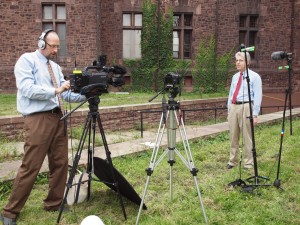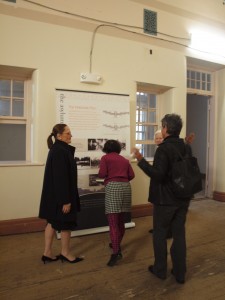
Steve Powell from Odessa Pictures sets up the interview with Richardson scholar Jeffrey Karl Ochsner in front of the Richardson complex.
My first venture into scriptwriting has become a blur, but the final product, a short film created by Odessa Pictures in Buffalo, is a stellar demonstration of a great preservation story. The Richardson Olmsted Complex, a National Historic Landmark in Buffalo, which I have written about extensively in this blog, was opened to the public for the first time in a decade during the National Preservation Conference in October. In order to prepare for this opening, the Richardson Center Corporation board spent two years overseeing restoration work, stabilizing parts of the complex for life safety and access and developing a story line which was presented in this film and in an exhibit. Although we were talking about it for two years, of course it all came down to the wire. The exhibit panels arrived the day before the first tour, and the film was finished the morning of the first day it would be shown!
They Didn’t Teach Us This in Architecture School!
I have been on the Richardson Architecture Center board since 2007 and have been focusing on how to tell our story. I stepped off the board for six months to assist our Project Coordinator, Monica Pellegrino Faix, with all of the work that needed to be completed to get ready for the conference and make our showcase space ready for development demonstration. Our filmmakers, Steve Powell and Suzie McGowan, worked closely with us to make the film. We started out by having a half day workshop with board members and local architectural historian phenom, Martin Wachadlo , to lay out our storyboard. We wanted the film to be 5-7 minutes long, but discovered very quickly how impossible that was!! Ultimately it ended up being 9 minutes long but does manage to tell the past, present and future of the site through the voices of some key community members and national scholars.
This was the second architectural documentary I’ve been involved with, but this involvement was a bit more intense. The first one was a documentary on the Pioneer Courthouse in Portland, Oregon when I worked for GSA. But with a full-time production and writing staff at GSA, I really just needed to provide the direction and overview. With this film, “Richardson Olmsted Complex: Architecture, Landscape, Community” I wrote the base script with Monica. We then used the script as the basis to identify the interviewees for the film and prepare the questions for them. We were lucky that the actual interviews ended up working well enough and covering all of the content. The film debuted at the Preservation Partners reception on October 18th, one of the first big events at the National Preservation conference.
Coordinating The Film with Exhibits

The “Preservation” exhibit panel in the connector between Buildings 45 and 10, note the restored Minton floor tile.
At the same time as the film was being developed, we were working with a design team at Lee H. Skolnick Architecture + Design Partnership to create a movable exhibit. Using the same text as the film, we developed seven exhibit locations which are used to take visitors throughout the spaces in Buildings 45 and 10. Scott Briggs and Daphne smith guided us through the process and worked magic with our text and images. I wish we had someone taking photos of Monica and me figuring out how to set up the panels, they knocked us over a few times, but we figured it out and managed to get them up one whole day before our first public tour on Saturday, October 15th.
We welcomed almost 2000 people to the complex that third week of October through conference sessions, public tours, and a big open house. We posted the film to YouTube last week and already have almost 400 views! Now we are taking the next step and have just put out a Request for Qualifications for an architectural team to design the core rehabilitation project (the core three buildings of the Towers, and the wards on either side).
Follow Your Dreams
I share this story as my first blog in the new year, because I know that our field is still hurting from the recession. An article in the Washington Post last week declared that architectural graduates have the worst percentage of unemployment, even more than art degree graduates. I have been so incredibly fortunate in my career to work on some of the most important landmarks in the country. The Richardson complex guided my choice of career and I have now worked on it in various capacities for 25 years. The history and architecture of the former Buffalo State Asylum for the Insane is one that spoke to me early on and drove me to seek out this field. It is a hard time for students and architects alike but never forget why you went to architecture school in the first place. Sometimes you’ll find yourself doing things you never anticipated like writing film scripts and working on exhibits, but that is one of the beauties of this field, there are many options and choices, and hopefully this economy will not make us lose a whole generation of our creative class.
And if you’d like to “subscribe” or follow this blog, True Green Cities, please sign up through the “Subscribe” button at the bottom left of this page. You’ll receive a daily recap when new blogs are posted.


